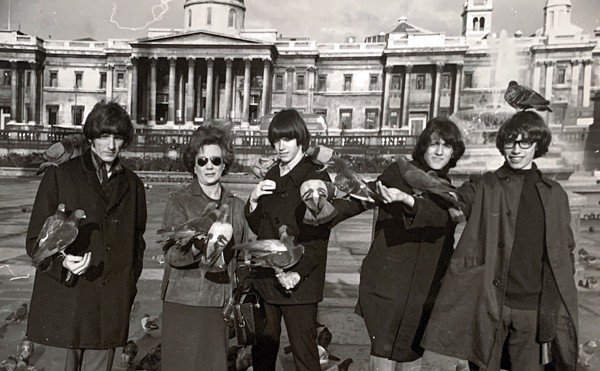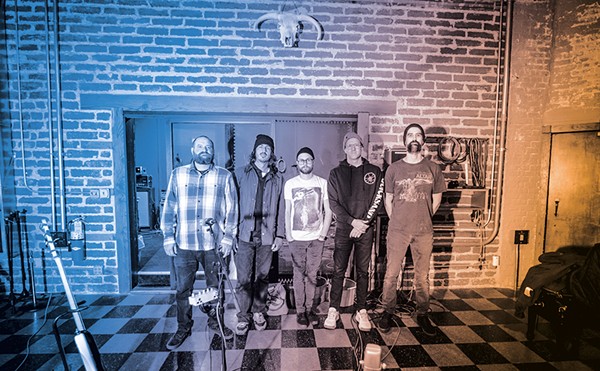But the story's been told of Starbuck, musician, artist, sci-fi junkie, futurist, dadaist and DJ, doing just that: standing in a crowded Schnucks looking typically glammed-up (face paint, dyed hair, futuristic dress, sparkly face) — he dresses this way all the time and sticks out in such a setting like Marilyn Manson would at a Merle Haggard concert — and seeing a dreadlocked acquaintance behind him in line. In typical Starbuck fashion, rather than simply saying "Hi" and then chitchatting with the friend, he blankly glances at the man, pretending he doesn't know him, then stares at the dreadlocks with faux derision as strangers watch and shouts for all to hear, "Oh my God! Look at your hair!"
That's Tory Z. Starbuck, constantly, habitually — some would say obsessively — questioning assumptions and perceptions about proper behavior, drawing attention to himself and the way he looks and using humor as a means of examining society's insistence on "normalcy."
By his own estimation, Starbuck has released, both solo and as member of various groups, more than 100 recordings. His two most recent, Scoping Futures and Long Live the Jet Age, are pretty much standard fare in the Starbuck oeuvre: an avalanche of synthesizers, a dabbling in guitars and beats, an identifiably progressive — as in "prog-rock" — approach to music creation, a vocal moan that runs from gruelingly deep to gratingly steep tones, and the thematic base of his entire output: science fiction and the future.
He's been involved in the St. Louis music scene since the late "70s, when he was sitting in with early St. Louis punk bands the Oozekicks, the Rude Pets and Be-Vision. Since then he's played in a half-dozen-or-so bands, including, most recently, Next Radio (which disbanded two years ago after existing for the better part of the '90s) and hosted a show on KDHX, Nocturnal Designz (Fridays, 2 a.m.-4 a.m.) for close to a decade. The thread that's connected them all is Starbuck's fascination with synthesizers. It's an affair that's lasted since he first heard one on an Elton John album in the mid-'70s and that has gradually snowballed to include nearly every innovator the instrument has produced. He'll name-drop early pioneer Morton Subotnick alongside proto-synth-poppers Kraftwerk; discuss Brian Eno and recent pioneers Add N to (X); dive into a lengthy discussion of Ultravox. It's all there, along with an encyclopedic knowledge of all of his music equipment.
Keyboards line the walls of his home studio, and as he walks around the room he discusses the company that made each instrument, where he bought them, why he likes them. Any potential lull in the conversation is deflected as he turns his back and fiddles with another piece of equipment. There's a jerry-rigged analog synth that some Wash U. students created; an old Moog replica; a few Korgs; a drum machine; a Tascam four-track recorder; a CD duplicator; a few angular electric guitars. Opening a closet, he pulls out a chin — a Chinese hammered dulcimer — fiddles with it, sampling its sound and expressing frustration with its precise tuning arrangements ("You tune it for hours, and it doesn't stay in tune for a long time."). But it's the synthesizer that's clearly won his heart.
"Basically, once you plug it in," says Starbuck, "it's taking the sound of electricity from the socket and then (points to the electrical cord) it goes through there. It starts out with, like, a square wave. And then you alter the square wave to become a sine wave, or a triangle wave. It's actually harnessing the sound of electricity that comes from Cuivre River (a local electric cooperative), and it makes a sound. I like that, that you can tweak electricity."
Ironically, Tory Z. Starbuck, at this point, is a pretty normal guy, even though his version of normalcy and yours, at least superficially, may vary. You say "Hi." He says "Meow." You say "Bye." He says "Meow." You get a butterfly tattooed on your butt; he paints Asian symbols on his face, carves purple angles with makeup on his forehead, wears sparkly white platform shoes.
You see him, and you think he's — to use one of his favorite words — weird, but because it seems to be genetic — he's been dressing this way since he was 12, and he's in his 30s now — his routine is the same as your putting on Levi's, a pocket T and Doc Martens. Where you would feel uncomfortable wearing his getup, he'd be equally uncomfortable in yours.
When Starbuck was last featured in the paper, in March 1993, he looked, well, nearly identical to his appearance during my recent visit to his home. The hair's the same — a sculpted black swoosh — as is his taste in clothes (triangular cyberpunk new wave) and his fondness for offering opinions on music creation, fashion and the intermingling of the two. "It all goes together," says Starbuck, who's a thoughtful and articulate speaker, of his aesthetic. "Since it all revolves around science fiction, I would feel weird if I put on a pair of jeans and a flannel shirt and a baseball cap and stood at the synthesizer. I mean, it would be funny, it would be an ironic thing, but I would still be really uncomfortable. The whole reason why I got into that was I always thought science fiction, Dr. Who, synthesizers, and I like the whole thing together. It's just me. It's my — I've gone to see bands who could care less (about how they look) and what I do is, I pay more attention to the music. But I do usually like the whole package."
On last year's Scoping Futures and his most recent release, Long Live the Jet Age, Starbuck and his band (Venus Slick on "elektronik percush, sequencer, synthesizers, treatments, objekts"; Jun Sugatani on bass; Erin Neill on electronic cello) concoct a concept and a storyline, then step inside. The artificial sounds they create rely on digital beats; swaths of fuzzy noise; a solid, centering bass line; and Starbuck's curious voice. The irony of his music, though, is that he's describing a future using a style that seems to exist almost solely in the past. His lifelong musical passion is David Bowie. And though the current popular fascination with digitally based music suggests that Starbuck is on the cutting edge, he relies on equipment that is at least a decade old. Most of it he finds in used-equipment stores and pawnshops. His musical approach is drawn nearly completely from yesterday's styles. You can hear a touch of Bauhaus here, a spot of Japan there, some Gary Numan and lots of Bowie. And though the music varies from song to song, Starbuck's vocal technique remains similar throughout, drawing from, he says, Peter Murphy, Bowie and Ric Ocasek of the Cars.
He admits that he's no vocal virtuoso (though his musical grasp of tunings and instruments is unparalleled); he says he loves female Middle Eastern singers and expresses frustration that he's unable to replicate their vocal gymnastics. But, admirably, he views every aspect of his music as a work-in-progress. "I'm not in a hurry. All the CDs, to me, are a sort of schooling. And why apologize for not being a virtuoso on some instrument on a CD, knowing that by next year it's going to sound a whole lot better?"
For his next album, already titled Air Zone, Starbuck has developed a concept, one that resembles those of his previous two releases: "This one is a biblical science- fiction detective story. I know it sounds funny. But, see, I've always been into God, and people just think that's stupid. And I don't mean in any church way, but to me, that's the whole reason why I do this. Like, here's this power, this entity, and I can't prove that it exists, but it doesn't bum me out to think that it does. This is my church; my way of celebrating is through the art. And so the whole concept of Air Zone is, this (Japanimation character) Aeon Flux-type character — which is Venus — has been sent on a mission to go to Arizona, which is this place where the good and evil — it's in the future — and there are these people who sort of follow Terrence McKenna and do DMT and that's their Holy Communion. DMT's this drug that's supposed to take five minutes. I think people smoke it, and it's supposed to take them real far away."
Not coincidentally, Starbuck and Venus are in reality considering a move to Arizona; a recent visit there left them awestruck. The most wonderful thing about Starbuck's vision is that it's filled with wonder, and he follows it wherever it takes him. "What's funny is, the reason we went to Arizona is that we bought this book and it had this really neat architecture in it. And Venus looked at this building and said, "What is that?' And we found out it was this school in Tempe, their art school (the Arizona State Arts Center), and it was done by Antoine Predock, this architect that lives in New Mexico who was influenced by John Cage and Merce Cunningham's dance and thinks of architecture along those same lines. He said you should be able to take the concept of Mary Poppins and William Gibson and blend it all up and put it in stuff. And that's the whole idea of my music."





